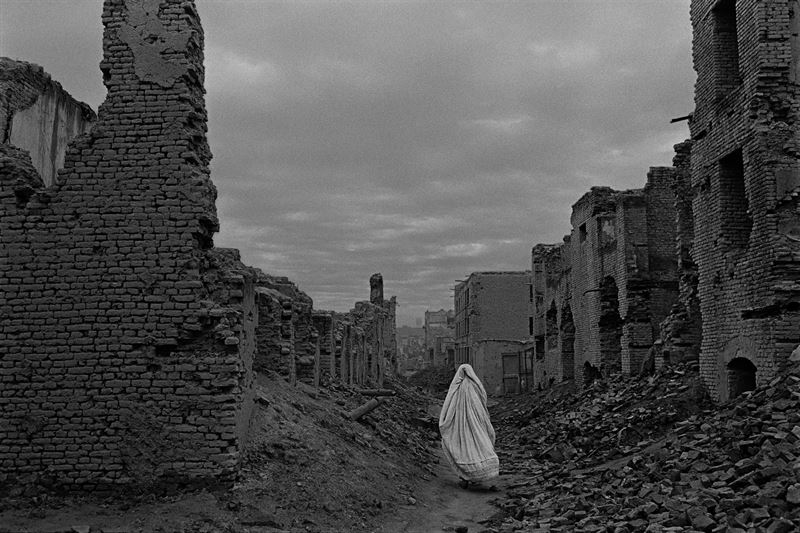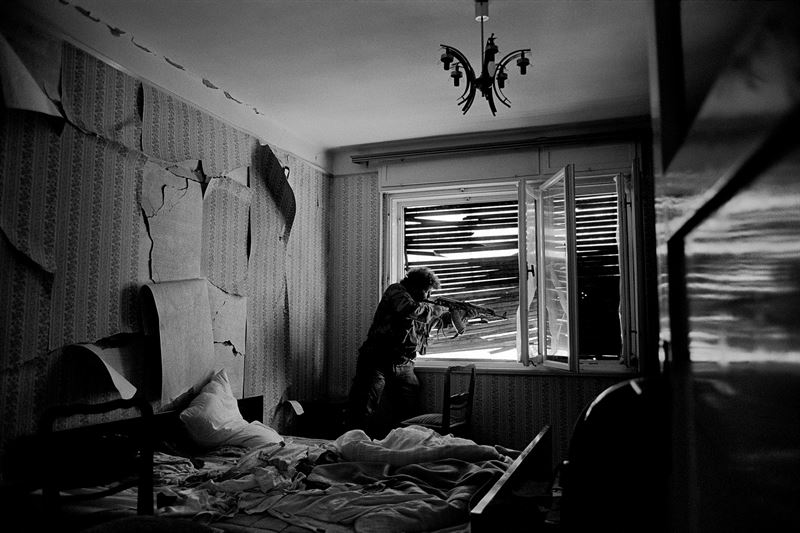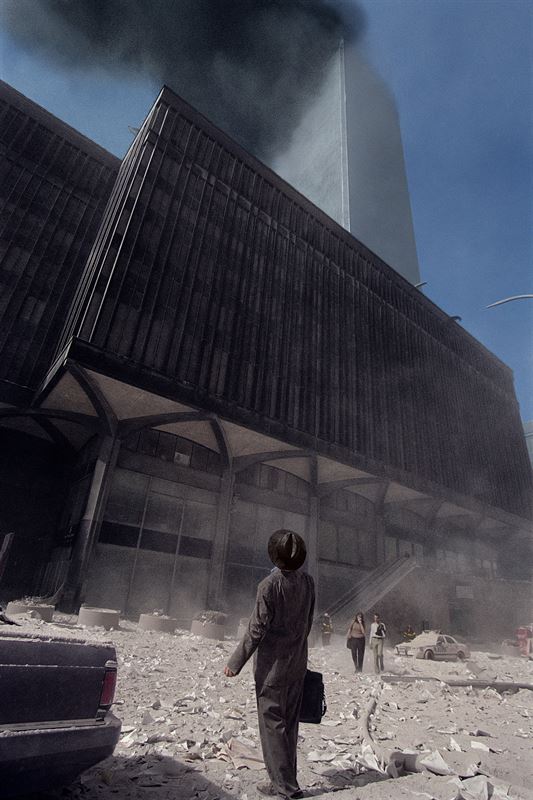James Nachtwey calls for peace with Memoria at Fotografiska Stockholm
Memoria
James Nachtwey 14 June - 15 September Fotografiska Stockholm
James Nachtwey, one of the world's most respected photojournalists, and considered the defining visual war reporter of his time, will be exhibiting a major retrospective, Memoria, at Fotografiska. The photographs in the exhibition are arranged in narrative sequences that include many of Nachtwey's most prominent bodies of work with almost 150 photographs and a film by Thomas Nordanstad.
James Nachtwey was born in the state of New York and graduated from Dartmouth College, where he studied art history and political science. He was influenced to become a photographer by images of the Vietnam War and the American Civil Rights Movement. He began his career as a newspaper photographer in 1976 and became a freelance in 1980. Since then, he has worked worldwide, committed to documenting wars and critical social issues.
Nachtwey has been a contract photographer with TIME Magazine since 1984. He was a member of Magnum between 1986 and 2000 and was one of the founders of the photo agency VII, where he was a member from 2001 to 2008, when he became independent.

Photo: Afghanistan, Kaboul, 1996 © James Nachtwey Archive_ Hood Museum of Art, Dartmouth
Nachtwey's images focus on the impact of injustice and violence, yet they evoke a sense of compassion and sympathy. Within large-scale historical events of global impact, he documents intimate moments of humanity. His photographs can appear to have a formal completeness, but they are spontaneous, intuitive and often composed in a fraction of a second.

Photo: Bosnia-Herzegovina, Mostar, 1993 © James Nachtwey Archive, Hood Museum of Art, Dartmouth
”As a photographer, he is gifted with the ability to capture striking compositions, acting as an observer of the world in which we live often endangering his own life, but always with the greatest respect for the most vulnerable – the civilian casualties. Nachtwey is an acute witness, who has devoted his career to documenting some of the most crucial issues of contemporary history. That Fotografiska now show this extraordinary important exhibition Memoria is part of our vision to inspire a more conscious world”, says Lisa Hydén, Exhibition Manager at Fotografiska.

Photo: West Bank, Ramallah, 2000 © James Nachtwey Archive, Hood Museum of Art, Dartmouth
To quote the film director Wim Wenders during the laudatory speech when Nachtwey received the Dresden Prize:
“...because he has never stopped believing that there is reason behind his work, because he has never stopped believing that his images have their greatest possible effect only if the eye and the heart behind them have an unfailing faith in humanity and its ability for compassion. For all of these reasons and many more we should stop calling him a “war photographer.” Instead, look upon him as a man of peace, a man whose longing for peace makes him go to war and expose himself… in order to make peace”.

Photo: New York, 2001 © James Nachtwey Archive, Hood Museum of Art, Dartmouth
Nachtwey has received numerous awards from the journalism profession, as well as for his contributions to art and to humanitarian causes. In 2001 was a recipient of the Common Wealth Award. In 2003 he received the Dan David Prize, and in 2007 the TED Prize as well as the Heinz Award, for Arts and Humanities. In 2012 he received the Dresden Prize, for promoting international peace. In 2016, Nachtwey was a recipient of the Princess of Asturias Award. In 2017, he was inducted into the International Photography Hall of Fame.
Five times Nachtwey has been awarded the Robert Capa Gold Medal, for exceptional courage and enterprise. He has been named Magazine Photographer of the Year eight times. He’s received the top prize from the World Press Photo Foundation twice, the Infinity Award for photojournalism three times, the Bayeaux Award for war correspondents twice and the Leica Award twice. He has been the recipient of lifetime achievement awards from the Overseas Press Club, TIME, Inc., and the American Society of Magazine Editors. In addition, he has received the Henry Luce Award for corporate leadership, the Leipzig Foundation award for the advancement of freedom of the press, and the Dr. Jean Mayer Global Citizenship Award.
In 2001, “War Photographer”, a feature length documentary film, directed by Christian Frei, about the life and work of James Nachtwey was nominated for an Academy Award. His books include Deeds of War and Inferno.

Photo: Soudan, Darfour, 2003 © James Nachtwey Archive, Hood Museum of Art, Dartmouth
Nachtwey’s photographs are included in the permanent collections of the Museum of Modern Art, the Whitney Museum of American Art, the San Francisco Museum of Modern Art, the Boston Museum of Fine Arts, the Bibliotheque nationale de France, the Pompidou Center and the Getty Museum among other venues. He has had numerous solo exhibitions worldwide.
He has received honorary doctorate degrees from Dartmouth College, Academy of Art University, Massachusetts College of Art and St. Michaels College and an honorary professorship from Shandong University.
As he continues his work in the field as a practicing documentary photographer, Nachtwey has become a Provostial Fellow at Dartmouth, which has acquired the archive of his life's work.
Footnote: The press pictures is not allowed to be cropped, just for press publishing during and till the end of the exhibition period at Fotografiska.
Facts about Fotografiska: Fotografiska Stockholm is not only the world’s most esteemed museum dedicated to the world of photography. The concept also contains an internationally awarded restaurant elected “the Museum Restaurant of the Year 2017”, as well as inspiring event spaces, an acclaimed academy and a shop featuring an extensive selection of photographic books.
With a great network of world-class photographers at the core, Fotografiska Stockholm has since the opening hosted more than 170 exhibitions, including the work of iconic masters such as Annie Leibovitz, David LaChapelle, Irving Penn, Helmut Newton, Sarah Moon, Nick Brandt and Andres Serrano, as well as up-and-coming young photographers.
By taking a stand in controversial issues and stretching their responsibility far beyond the realm of traditional art institutions, Fotografiska has a history of acting as an influencer, playing an active role in the Swedish society.
The purpose is simple, to use the power of photography to unite, spread awareness and create positive impact.
To inspire a more conscious world.
Initially opened in Stockholm in 2010 the Fotografiska family is now growing and are expanding to Telliskivi Creative City in Tallinn and Park Avenue in New York. Taking on these prime locations Fotografiska aims to redefine the traditional museum experience by creating urban meeting places where global citizens are invited to dwell, get inspired, question the taken-for-granted and grow as individuals.






